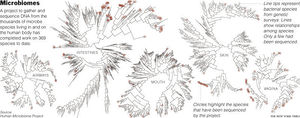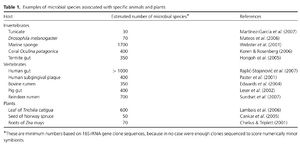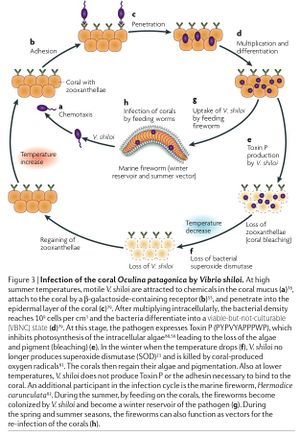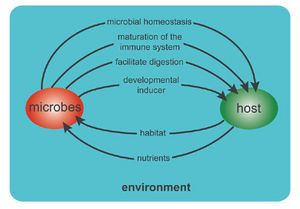The Hologenome Theory of Evolution
Introduction
The hologenome theory is a postulate put forth in 2007 by Eugene Rosenberg and Ilana Zilber-Rosenburg stating that the object of genomic natural selection is not a single organism, but the organism and its microbial communities (Rosenburg et al., 2007). This theory was originally based on the pair’s observations of Vibrio shiloi-mediated bleaching of the coral Oculina patagonica (Rosenburg & Zilber-Rosenburg, 2008); since its first introduction, the theory has been promoted as a fusion of Lamarckism and Darwinism (Rosenburg, Sharon, and Zilber-Rosenburg, 2009) and expanded to all of evolution, not just that of corals (Figure 1; Rosenburg & Zilber-Rosenburg, 2011).
New discoveries about changes in host fitness with alterations in gut flora--such as research dealing with pathogenic growth of C. difficile in the human intestine--suggests that the genomes of host-dwelling microbes must be taken into account along with that of the host when evaluating environmental selection pressures. In addition, recent research by the Rosenburg lab suggests that commensal bacteria play a role in mate choice by the fruit fly, Drosophila melanogaster, further supporting the hypothesis that greater genetic trends are determined by symbiotic microbiota (Sharon et al., 2010). The possibility of microbes affecting mate choice and speciation outside of the insect world could push common views of natural selection on the individual level toward the adoption of a hologenomic approach.
The Hologenome Theory
The Holobiont
The idea of holobiont is certainly not new: this term was coined originally by Margulis and Foster in 1991, and later adopted into various parts of evolutionary biology (Figure 1). The holobiont was appropriated for use particularly in reference to the large symbiotic communities residing in coral reefs (Rowan, 1998), and internet searches for this term primarily return research on coral communities. In general, a holobiont is any organism and all of its associated symbiotic microbes, including parasites, mutualists, synergists, and amensalists (Rosenburg & Zilber-Rosenburg, 2011). This is the unit of selection in the hologenome theory (as opposed to the traditional Darwinian theory, which states that individuals are the units acted upon by natural selection). The hologenome theory, while a new concept in name, has actually been considered in some form or another with the recognition of symbionts as important to host health (Slonczewski & Foster, 2011). Gilbert et al. (2010) refer to the development of the holobiont via selection of symbionts as symbiopoiesis, or codevelopment of the host and symbiont.
The Coral Probiotic Hypothesis: The Beginnings of the Hologenome Theory
Corals are a symbiotic partnership of many different marine bacteria, archaea, and eukaryotes with the invertebrate coral structure (Kushmaro & Rosenburg, 1997). Bleaching, or the loss of photosynthetic zooxanthellae from corals, is detrimental to the reef environment, as it inhibits shoal development and decreases biological production in the shallow ocean (Slonczewski & Foster, 2011). The 1980s and 1990s saw multiple large-scale bleachings of coral across the world’s oceans, largely the result of increases in ocean temperature (Goreau et al., 2000). Research of the Mediterranean coral bleaching in the mid-1990s used Koch’s postulates to show that growth of Vibrio shiloi, a gamma-proteobacterium, on the coral was responsible for the death of the required zooxanthellae (Figure 2; Fine & Loya, 1995; Kushmaro & Rosenburg, 1997).
In 2006, the Rosenburg lab published a paper titled “The Coral Probiotic Hypothesis” in the Journal of Environmental Microbiology (Reshef et al., 2006). Drawing from Fine & Loya’s (1995) findings that the coral contained large populations of cyanobacteria in its calcium carbonate skeleton, and combining this with the knowledge that changes in populations of microbes can allow the entry and growth of pathogenic species (Bignardi, 1998), the Rosenburg lab hypothesized that changes in temperature would alter microbe populations. Following the lab’s past conclusions, Reshef et al. asserted that temperature-mediated changes in symbiont species makeup allowed the colonization of the coral by Vibrio shiloi, and thus permitted the bleaching (Kushmaro & Rosenburg, 1997). Taking into consideration their more recent research that showed the development of resistance within coral populations shortly after the worst bleaching event in 1998 (Goreau et al., 2000), Reshef et al. argued that the a change of microbial communities within the coral—due to natural selection pressures exerted by the change in temperature—was responsible for macroscale adaptation on the part of the whole coral (2006).
The Hologenome Theory
In the hologenome theory, natural selection works on the level of simple Mendelian genetics, but also on a bigger scale. Certain microbiota are selected for based on the host environment as well as the other types of microbiota present (Arumugam et al., 2011).
Because the microbes associated with the larger host are so intimately tied to the organism, changes in either host environment or microenvironments within the host can cause changes in microbial genomes (Erlich, Hiller, & Hu, 2008; Gilbert et al., 2010). Thus, the genome being selected is not simply the host’s, but the hologenome—the genes of all of the microbiota as well as those of the larger organism (Rosenburg, Sharon, & Zilber-Rosenburg, 2009).
Larmarckism vs. Darwinism
In his 1859 work, On the Origin of Species, Charles Darwin put forth the famous “survival of the fittest” hypothesis (Darwin, 2003). This argued that evolution occurred through environmental selection of favored traits within a genetically varied population. Though the theory was met with much criticism at the time, it has come to be accepted as an accurate model for evolutionary progress (“Darwin,” 2006). This is the current model of evolution, wherein species are refined and created through gain or loss of individuals with changes in fitness for the particular environment in which they live.
During the same period as the publication of Darwin's theory, a French scientist named Jean-Baptise Lamarck published his book Philosophie Zoologique, which proposed that organisms were the result of spontaneous creation followed by slow evolution towards more complicated forms (Nelson, 1975). While this theory is largely discredited now based on Stanley Miller’s early earth experiments, which showed that complex molecules could assemble from simple ones, suggesting that organisms could evolve from long-term series of reactions of increasing complexity (Miller, 1953), Lamarck did have some theoretical points that—although once dismissed—fit well within Darwinian theory. These are:
(1)The theory of use and disuse: individuals within a species lose characteristics they don’t use and develop new characteristics they will use.
(2)The transfer of acquired characteristics through inheritance: new characteristics within a species will be passed from parent to child (Rosenburg, Sharon, & Zilber-Rosenburg, 2009).
Later arguments by August Weismann, who said that only germ cells—which do not transmit newly acquired traits—were the mechanism of inheritance, and Mendel, whose genetics experiments suggested that variation was the result of random mutation within the population, caused the dismissal of Lamarckian theory from biological memory until recently (Mayr, 1985; Rosenburg, Sharon, & Zilber-Rosenburg, 2009). In 1983, Buss argued against the idea of germ cells being the sole unit of selection in his article, "Evolution, Development, and the Units of Selection", which cited key evidence that somatic cells could also transfer genetic information, particularly in fungi, protists, and plants, not to mention animals. Subsequent new research has shown that evolution is not simply a product of germ cell genes: DNA methylation, and RNAi, for example, alter the expression of genetic code based on environmental signals (Slonczewski & Foster, 2011).
While the Lamarckian principles of “use and disuse” and inheritance cannot be exemplified under the theory of simple host-organism Mendelian genetics, they can be shown within the holobiont. For example, increases in certain strains of symbiotic bacteria, if looking at the hologenome, count as gene amplifications, since each new bacterium carries copies of the bacterial genome. In this case, changes in environment cause changes in microbial communities that are transmitted to the entire organism—potentially changing metabolism or causing a pathogenic state (Rosenburg, Sharon, & Zilber-Rosenburg, 2009; Ehrlich, Hiller, & Hu, 2008; Gilbert et al., 2010). With changes in environment that change use of certain microbes by the host, then, we see a direct increase or decrease of the microbial population, which, in terms of the holobiont, is equivalent to changes in gene prevalence.
The same “use and disuse” strategy can be seen in the acquisition of new microbes from the environment. When new microbes are present in the host organism, they are either outcompeted by existing symbionts (“disuse”) or they outcompete (“use"). In this latter case, the new microbes establish residence within the host; when this occurs, their genomes become part of the hologenome of the host and its microbial partners (Figure 3; Zilber-Rosenburg & Rosenburg, 2008).
Though once inheritance of microbiota was deemed impossible due to the “Weismann barrier,” which held that germ cells were sole vehicles of heredity (Buss, 1983; Rosenburg, Sharon, & Zilber-Rosenburg, 2009), this is no longer found to be the case. In many plants (and some animals), vegetative reproduction uses somatic cells rather than gametes to form offspring; in this case, the offspring will gain any mutations acquired by the body cells (Rosenburg, Sharon, & Zilber-Rosenburg, 2009). Indeed, the easiest place to see this is the eukaryotic chloroplast or mitochondrion, which are maternally inherited degenerate alpha-proteobacterial endosymbionts (Dimijian, 2000). In addition, many endosymbionts are passed via the oocytes to the offspring (Rosenburg, Sharon, & Zilber-Rosenburg, 2009). In mammals, many endosymbionts are transmitted through infant contact with the birth canal or through breast milk (Martens, Chiang, & Gordon, 2008; Hehemann et al., 2010). The fact that gnotobiotic mice colonized with human intestinal flora have been shown to reliably transmit these microbes to their offspring illustrates the potential for inheritance of the hologenome outside of germ cell lines (Turnbaugh et al., 2009).
None of this is to say, however, that the hologenome theory does not fit within the Darwinian understanding of evolution. To the contrary, evolutionary process may be seen as “survival of the fittest” in which it is the whole organism—the host plus its "tagalong" microbes—that is being selected for (Figure 3). This theory allows for the rapid gain and loss of helpful traits, since microbial genomes are generally smaller, more easily mutated, and more rapidly transmitted—through vertical or horizontal transmission—than those of larger organisms (Slonczewski & Foster, 2011). Research into parasitism in host organisms has shown that parasites adapt more rapidly to their hosts' environments than the other way around, further suggesting that the mechanism of larger host adaptation is based on alterations in microbe population or capabilities (Schulenburg et al., 2011).
Examples of the Hologenome Theory at Work
Microbial Symbionts' Effects on Human Fitness

It has long been known that the presence of microbes is essential for human and animal development (Wostmann, 1981). However, it was only in recent years that the extent of microbes' effects on the human race was acknowledged and more carefully researched. In 2007, the NIH Common Fund began the Human Microbiome Project, an initiative whose focus was the sequencing of every symbiotic microorganism on the human body in order to gain a better understanding of the human holobiont (Figure 4; "Human Microbiome Project (HMP), 2007).
Recent research into the microbe's function in development has cited stimulation--and suppression--of the immune system as an important role of human symbionts (Mazmanian et al., 2005;Smits et al., 2005). Microorganisms have also been implicated in vitamin production, digestion, and angiogenesis in the human body (Slonczewski & Foster, 2011; Rosenberg & Zilber-Rosenberg, 2011). Mice born "germ-free" have longer digestion times and lower metabolic rates than those that have been normally colonized (Wostmann, 1981).
Perhaps the most essential role of microbiota, though, is not their direct contributions to the human body, but rather the protection that they offer against the growth of pathogens. As seen in the research that led Reshef et al. (2006) to propose the "Coral Probiotic Hypothesis", recent papers have cited the alteration of environment and subsequent changes in microbial populations as the source of increases in opportunistic infection of patients. Clostridium difficile, for example, is an opportunistic pathogen of the intestinal tract, causing chronic and debilitating diarrhea in patients whose gastrointestinal flora have been altered by the administration of certain antibiotics (Bignardi, 1998). In some patients, these infections are nearly impossible to treat, as normal intestinal flora cannot reestablish residence in the infected tract; in these cases, fecal transplants from healthy patients to the infected patients have been shown to recolonize and outcompete the pathogenic C. difficile (Silverman et al., 2010; Rohlke et al., 2010). Without these transplants, the patients would die. This phenomenon illustrates the hologenome theory's assertion that environment-mediated amplification of certain bacterial genes (in this case, the pathogenic C. difficile) will change the phenotype of the larger holobiont (the human patient) and alter his or her fitness (Rosenberg, Sharon, & Zilber-Rosenberg, 2009). From here, traditional Darwinian selection will take place (Darwin, 2003).
New research into the human gut metagenome has revealed three distinct "enterotypes", cited as potentially analogous to the ABO system that revolutionized blood transfusion (Arumugam et al., 2011). Authors of this cross-cultural study assert that the human gut primarily favors growth of either Bacteroides, Prevotella, or Ruminococcus species, and that this primary bacterial framework affects the growth of lesser species, dictating the entire microbial makeup of the gut. Though these findings are still of dubious significance, since host properties such as age, gender, body mass index, or race did not seem to relate to microbial composition (for the most part--Bacteroides species tended to predominate in Japanese individuals, making enterotype 1 most common in people of this nationality), higher levels of certain mutualistic gene products in individuals belonging these categories suggest the upregulation of these pathways by symbiotic bacteria. This supports the Lamarckian principle of "use and disuse" within the hologenome theory, where characteristics of benefit to the holobiont are gained or amplified by alterations to microbial genomes and genomic expression (Rosenberg, Sharon, & Zilber-Rosenberg, 2009).
Microbes' Influence on Mate Selection in Drosophila melanogaster
In 2010, Sharon et al. announced that flies raised on specific media—either molasses or starch—tended to mate with those of the same past. However, when these flies were treated with antibiotics attacking gut microbiota, this preference was eliminated (Sharon et al., 2010). Previous studies have shown that microbiota vary with diet (Rosenburg, Sharon, & Zilber-Rosenburg, 2009), and that changes or absences of microbes in large eukaryotic organisms causes decreased fitness and loss of important social and reproductive traits (Singh, et al., 1990; Fraune & Bosch, 2010). Sharon et al. suggest that the changes in mating patterns are due to alterations in the Drosophila sex pheromones modified or secreted directly by the microbes inhabiting the fly (Figure 5; 2010).
Early research into mating preferences by the fly Drosophila melanogaster indicate that sexual selection is largely based on olfactory signals (Figure 5; Ehrman, 1969). Subsequent research on the science of human attraction has indicated that scent is extremely important for Homo sapiens as well, and, as in flies, is arguably more important for female selection of mate than male (Andreae & Younger, 2009; Thornhill & Gangestad, 1999; Herz & Inzlicht, 2002).
Later research by Ringo et al. supports this conclusion: "Bacteria-induced sexual isolation in Drosophila," a paper published by the group, indicates that microbial inhabitants of the fruit fly gut altered hydrocarbons, which function as insect pheromones (Ringo et al., 2011). The idea that symbiotic bacteria produce pheromones for their larger hosts is hardly a new one--a letter to Nature in 1971 discusses the evidence that the symbiotic species in Lepidoptera and Coleptera orders (Hoyt et al., 1971). However, it is only recently that the scientific community has acknowledged the extent to which bacterial symbiosis might affect evolution of holobionts (Dillon & Dillon, 2004; Koukou et al., 2006; Vala et al., 2004). The Ringo et al. (2011) paper also notes that Wolbachia species of endoparasites have been shown to affect mate choice in Drosophila quite strongly, evidence of Lamarckian phenotype transfer outside of the germ cell (Koukou et al., 2006; Rosenberg, Sharon, and Zilber-Rosenburg, 2009). Evidence of this phenomenon in other organisms as well lends further credibility to the argument that symbiotic bacterial populations might affect larger mate choice and speciation events (Gilbert et al., 2011; Vala et al., 2004).
The reason for the mating preference in the first place, however, is not apparent, and Sharon et al. do not address this. While the paper argues that the preference for flies with the same eating habits—and theoretically, then, the same geographic location—minimizes intergroup mingling and encourages speciation, the reason for this being preferable is not apparent. In many cases, the purpose of sexual reproduction seems to be production rather than minimization of genetic variation, particularly when mating within your own group is likely to produce incestuous relationships. This is the case with human females, at least, who are entirely unattracted to the scents from those related to them (Andreae & Younger, 2009). Similarly, Ehrman's 1969 research into the mating preferences of Drosophila melanogaster showed that females preferred "rarer" males with less common phenotypes. Why flies would then be attracted to those with only the same eating habits as them seems to be an anomaly left unresolved in Sharon et al.'s most recent paper.
Conclusion
While the hologenome theory is still under contestation (Leggat et al. 2007; Rosenberg et al., 2007), it has gained some popularity within the scientific community as a way of explaining quick changes in adaptation that cannot be justified with traditional Darwinian thought. The holobiont, originally the designation for hard-to-quantify coral communities, has, in some eyes, at least, become the major unit of natural selection within the larger environment. The 2007 launch of the Human Microbiome Project by the National Institutes of Health has reinforced the idea that microbes are indispensable parts of human health, but whether this principle will be extended to encompass all of evolution remains to be seen. Certainly, recent research on the effects of microbial populations on the fitness and mating preferences of larger hosts must be taken into consideration when evaluating the legitimacy of the assertion that it is the holobiont, not the individual organism, that is the object of natural selection (Silverman et al., 2010; Rohlke et al., 2010; Sharon et al., 2010; Ringo et al., 2011).
References
(13) Fine, M., and Loya, Y. 1995. The coral Oculina Patagonica: A new immigrant to the Mediterranean coast of Israel. Israel Journal of Zoology 41: 81.
(19) “Darwin.” 2006. The American Museum of Natural History. New York, NY. <http://www.amnh.org/exhibitions/darwin/>
(20) [http://www.jstor.org/stable/4025218, Nelson, Gareth. 1975. Reviewed work(s): Inedits de Lamarck. D'apres les Manuscrits Conserves a la Biblioteque Centrale du Museum National d'Histoire Naturelle de Paris. by M. Vachon; G. Rousseau; Y. Laissus. Systematic Zoology 24 (2): 271-275.]
(22) Mayr, E. 1985. Weismann and Evolution. Journal of the History of Biology 18(3): 295-329.
(29) Zimmer, C. 12 July 2010. How Microbes Defend and Define Us. The New York Times. <http://www.nytimes.com/2010/07/13/science/13micro.html?pagewanted=1>
(31) “The Human Microbiome Project (HMP).” The NIH Common Fund. Online. 2007. Accessed 10 May 2011. <http://commonfund.nih.gov/hmp/>
(37) Andreae, Simon, and James Younger. 2009. The Science of Sex Appeal. The Incubator, Film.
(40) Ehrman, Lee. 1969. The Sensory Basis of Mate Selection in Drosophila. Evolution 23(1): 59-64.
(47) Hoyt, C.P., G.O. Osborne, and A.P. Mulcock. 1971. Production of an Insect Sex Attractant by Symbiotic Bacteria. Nature 230: 472-473.</FONT-SIZE>
Edited by Rachel Chelsea Ann Martin, student of Joan Slonczewski for BIOL 238 Microbiology, 2011, Kenyon College.




